Myth & Math
Ancient Astrology for Modern Times
“The planets, moons, thunderstorms, volcanoes, rocks, even specs of dust. They are all symbols of transcendence… The world around you is a book waiting to be deciphered.”
― ‘More Than Allegory: On Religious Myth, Truth and Belief’ by Bernardo Kastrup
We fill the void of the unknown with story. Whether it’s an attempt to control the chaos around (and within) us; or a way to surrender to it – we create containers to shape our lives. Some seek guidance in religion, science, or art – others turn to the cosmos.
Whether you’re a skeptic (like my partner) or a believer (like myself), astrology has increasingly seeped into popular culture. It seems like nowadays everyone knows their Sun sign; blames mercury retrograde for their technology mishaps; or tries to find their love match according to the stars.
The rise of astrology is not new though. It’s been practiced for thousands of years – older than most religions. The first written astrological record originated in Mesopotamia (present day Iraq) in the 3rd millennium BC, with a series of Sumerian astrology tablets known as the Enuma Anu Enlil.
Astrology quickly spread throughout the world, with numerous cultures adapting its teachings to their customs, including China, Indigenous America, Egypt and India.
Throughout its various iterations, astrology has always bridged art and science – melding myth and math. The precision required to calculate planetary movements made the word “mathematician” synonymous with “astrologer.” Astrology was also studied alongside astronomy and advances in one field aided the other. In fact, Copernicus, who theorized that the Earth travels around the Sun, dedicated his main work to the astrologer Pope Paul III.
When it comes to myth, the Ancient Greeks were the first to apply the "animal circle" and imbue the zodiac with their divine stories. Astrology was highly regarded in Ancient Greece – including by Plato, Aristotle, and the stoics.
Astrology’s popularity fluctuated over the centuries. It boomed in Europe during the Middle Ages – when it was taught in universities and royals had court astrologers. It then waned during the Protestant era and the Age of Enlightenment, when it was viewed as merely entertainment.
Its function evolved over time, from a planting and harvest calendar and a navigation tool to a divination tool, and even a medical tool. Carl Jung was the first to use astrology in psychological analysis. Today, astrology is mainly used as a tool for self-realization.
Astrology’s main-stream trend often leads to the dilution of its teachings. A highly complex system has been turned into bite-size social media posts – losing all nuance in the process. Like my partner points out, “Not all Aries can be the same?!” And indeed, they’re not. No single planet tells a full story in astrology. The mythology is layered and the equation is infinite.
Others will also rightfully state how “astrology is a way for people to not take responsibility for their actions.” But any belief system – religion, money, technology – can be used as a justification for our behaviors.
To me, astrology poses the eternal question of self-will and divine destiny. I don’t think it’s an either/or question but rather a both/and paradigm – choice and fate can coexist.
Astrology highlights our individuality and our collective patterns – reminding us that our lives beat to a cosmic rhythm. After all, if the moon dictates the ocean’s tides and women’s menstruation cycles, why wouldn’t other planetary spheres also impact us?
I hope this month’s Seven Senses offers you a new perspective on astrology – see, hear, smell, taste, touch, balance and envision.
In Joy,
Sabrina
PS: For the astro-curious, I’ll be sending a personalized astrology treat to paid members for the upcoming new moon. Read more details under “Envision.”
SEE
“Astrology” Library of Esoterica | book series published by Taschen
Available at your indie library or online
The Library of Esorica book series, published by Taschen, has been catching my eye since its release a couple years ago. The one focused on astrology takes a unique approach, by presenting a visual art history of this ancient practice.
Edited by Jessica Hundley, the book includes 400 images that showcase the diverse interpretations and illustration of astrology throughout the centuries – from Egyptian temple manuscripts, to contemporary paintings by artists such Hilma as Klint, Manzel Bowman and Arpita Singh.
HEAR
“The Planets” | music composition by Gustav Holst
Listen online
Beyond the visual arts, the mythology of astrology has inspired many musicians and sound artists. One of the most literal sonic translations is “The Zodiac: Cosmic Sounds,” a collaborative psychedelic rock album, released by Elektra Records in 1976. A true relic of the time, it's set on a trippy background of electric guitar with twelve spoken-word tracks, an ode to each sign. It’s enchanting and amusing for its earnest translation of the zodiac.
However, a more obscure piece caught my attention – the classical music album “The Planets” by Gustav Holst. Composed between 1914 and 1917, it’s a sonic translation of the seven planets (known at the time) and their emotional influence on our psyche.
The idea for the album sprung when Gustav Holst took a holiday with friends and was first introduced to astrology by Clifford Bax, a writer with an interest in the esoteric. Holst became an astrology devotee and enthusiastic creator of horoscopes – and translated his new found passion into his music composition.
SMELL
Astrology Scents | olfactory exposé by Syd Botanica
I’m delighted to collaborate with my friend Sydney, an herbalist, artist and perfumer based in Los Angeles. We share a passion for the senses, and an affinity for astrology. So I’ve invited her to contribute to this month’s topic, guiding us into an olfactory astrology journey. In Sydney’s insightful words:
When it comes to scent, our lived experiences, culture and subconscious may inform our preferences in uniquely diverse and complex ways. Everyone’s story is an individually beautiful expression, and at the same time we are also linked by greater universal forces. Working with archetypes in astrology to recognize patterns can be a powerful tool for self discovery. When it comes to scent, our experiences are multifaceted. You can apply this guide to your sun sign, but also your moon, rising, mercury, venus and mars placements if you know them. Compare them against one another and see what resonates for you.
Aries
Empowering Spices: Cinnamon
Fresh & Energizing: Rosemary
Passionate Smolder: Sexy Musks
Taurus
Romantic Florals: Rose
Sensually Sweet: Vanilla
Earthy Sophisticated: Petrichor
Gemini
Uplifting Citrus: Bergamot
Stimulating Aromatics: Lavender
Playful Allure: Mango
Cancer
Soft Watery: Water Lily
Intoxicating Florals: Gardenia
Nostalgic Gourmands: Brown Sugar
Leo
Warm Citrus: Orange Blossom
Regal Garlands: Bay Leaf
Magnetic Charm: Amber
Virgo
Soothing & Refreshing: Cucumber
Healing Herbs: Clary Sage
Fresh & Clean: White Musk
Libra
Enchanting Florals: Cherry Blossom
Delicious Fruit: Strawberry
Flirty Sweets: Cotton Candy
Scorpio
Spicy Cool: Clove
Dark Seductive: Labdanum
Mysterious Resins: Opopanax
Sagittarius
Spicy Warm: Coriander
Wild Forage: Blackberry Leaf
Healing Resins: Piñon Pine
Capricorn
Chic Floral: Cactus flower
Relaxing Herbal: Davana
Deep Woods: Cedar
Aquarius
Naturally Distinctive: Tonka Bean
Genderless Fragrance: Sandalwood
Unique & Innovative: Space Accords
Pisces
Ethereal Florals: Frangipani
Milky Gourmand: Coconut Milk
Dreamy Oceanic: Salt water
TASTE
Cosmic Food | astrology ingredients
For centuries, astrology was used as a harvest calendar. Foods and their natural qualities became associated with certain planets and movement patterns. Still today, many gardener’s use a lunar calendar to guide their planting cycle.
Astrology, like Ayurvedic cooking, believes the elements (fire, earth, air, water) need to be balanced in order for the body and spirit to be healthy. Foods associated with the planets’ qualities are then used to harmonize our system.
Take it to heart or with a grain of salt, but I invite you to have an astrology culinary exploration. You can create a meal based on your Sun sign or your Ascendant (rising sign).
Sun I Leo: Sunflower seeds, habanero peppers, turmeric, olive oil.
Moon | Cancer: Water, cucumber, split peas, peppermint, blueberries.
Mars | Aries and Scorpio*: Chocolate, tomatoes, chilies
Venus | Taurus & Libra: Rose, butter, coconut, raspberries, avocado oil, cinnamon.
Mercury | Gemini: Parsley, peas, lemon, dill, lima beans, salt.
Jupiter | Sagittarius and Pisces*: Ginger, chickpeas, honey, CBD.
Saturn | Capricorn and Aquarius*: Cacao, black beans, sesame seeds, coffee.
Uranus | Aquarius: Lavender, pumpkin seeds, chamomile, dragon fruit.
Pluto | Scorpio: Red chili flakes, sugar, curry powder.
Neptune | Pisces: Seaweed, passion fruit, chocolate, anise.
* some signs have multiple ruling planets, according to the modern or ancient system (before Uranus, Neptune and Pluto were discovered).
TOUCH
Astrology body | physical cosmos
I recently learned that each zodiac sign also mirrors our physical body. Similarly to traditional Chinese medicine, astrology believes that every physical organ is imbued with certain qualities and linked to specific emotions.
Echoing our birth charts, we each have a unique set of spiritual and physical gifts and challenges. Some have an acute sense of balance, while others work well with their hands. Stress may show up as neck tension, headache, or a skin rash – we all react differently to our environments.
Following the zodiac order, the top of the head embodies the first sign Aries; while the last sign, Pisces, correlates to the feet. Here’s a scan of our cosmic body:
Aries: Head & Eyes
Taurus: Neck & Throat
Gemini: Hands
Cancer: Chest
Leo: Heart & Spine
Virgo: Digestive system & Spleen
Libra: Kidneys & Skin
Scorpio: Reproductive System & Hips
Sagittarius: Thighs
Capricorn: Bones & Joints
Aquarius: Ankles & Shins
Pisces: Feet & Lymphatic system
BALANCE
Jumbled Mantra | visual meditation by Kenshō studio
Astrology – as with most belief systems – is always posing the question of will versus destiny. Do we choose our life’s path? Or is it written in the stars? This month’s Jumbled Mantra came in the form of a constellation of words:
Choosing the mystery of destiny
I believe we have free-will – the ability to choose. I also think that we can align our will with a destined path – the lessons we’re meant to learn in order to grow. Can we hold the paradox in harmony?
ENVISION
Natal chart | your cosmic mythology
I invite you to look up your natal chart (also known as “birth chart”) – a snapshot of the sky the moment you were born. There’s many sites where you can get that information for free, including Astro.com and Astro Seek – you’ll just need to know your exact birth time.
Birth charts are like cosmic mandalas. They tell a unique story about each individual, according to the specific planetary placements; the angles they form in the sky; and their degree of relationship to one another.
Even if you don’t know anything about astrology, you can meditate on the unique geometry of stars and untangle the meaning of your own mythology.
I’ll be mailing a personalized astrology treat to paid members this month. If you’re interested, please respond, providing your:
Name
Birth date and exact birth time (precise hour and minute)
Birth location
Your mailing address (sent via analog mail)
More to be revealed on the new moon.



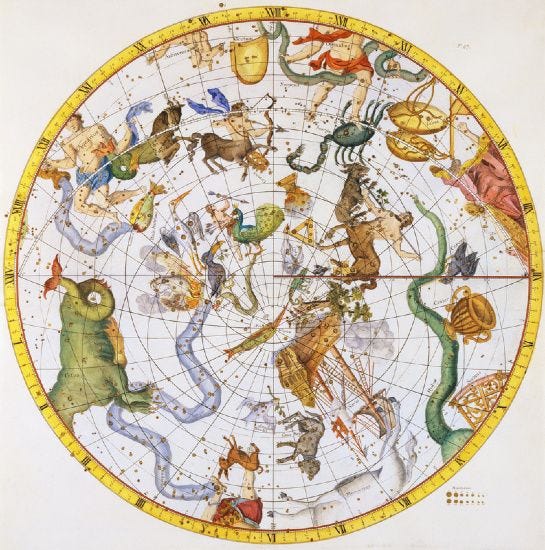
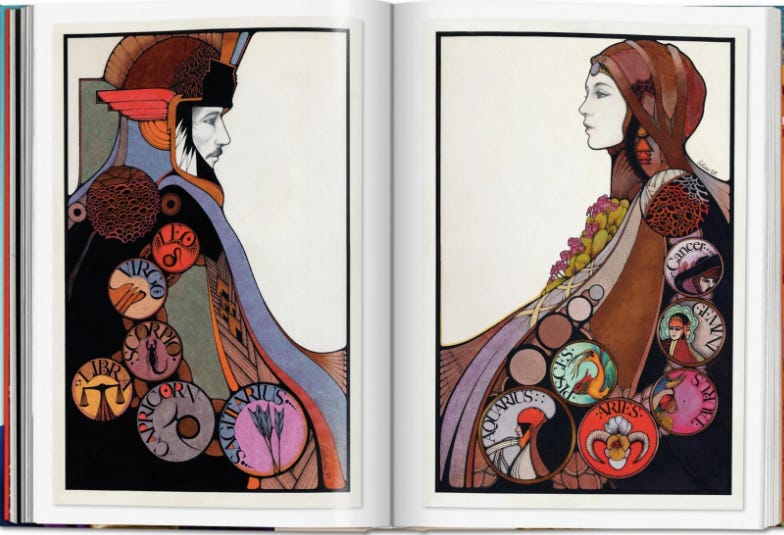
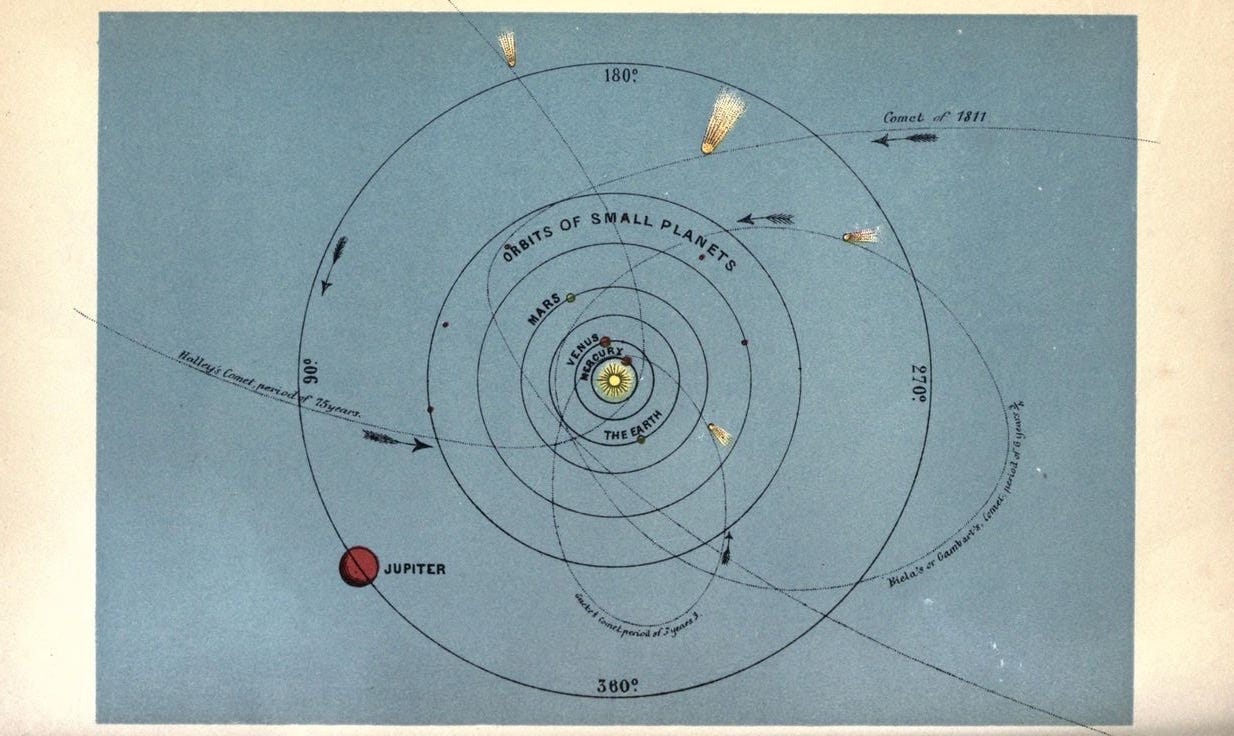
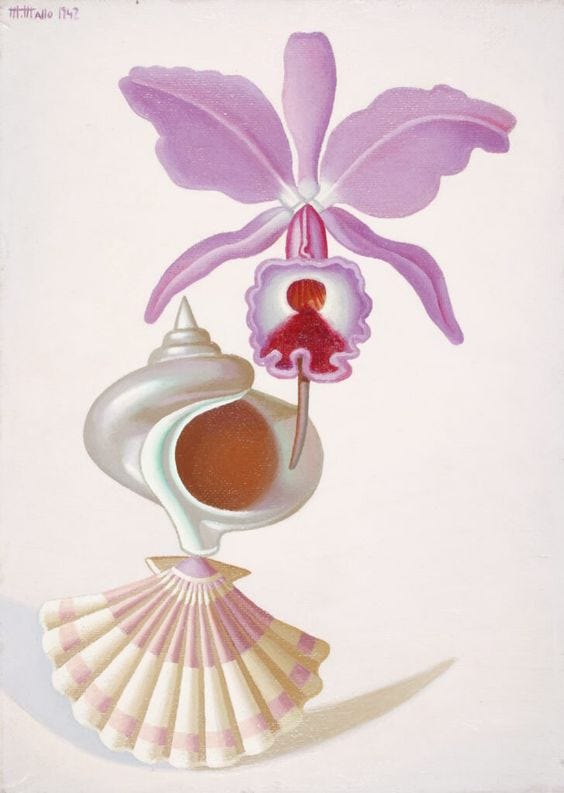
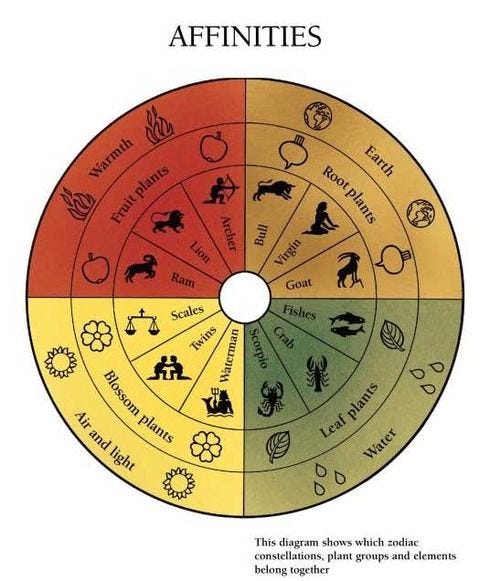
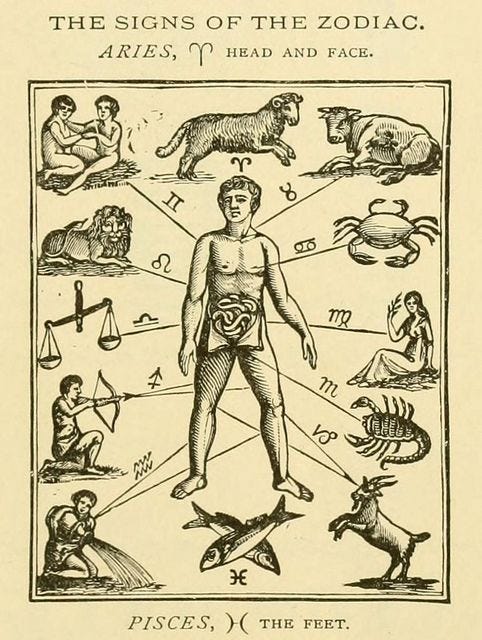
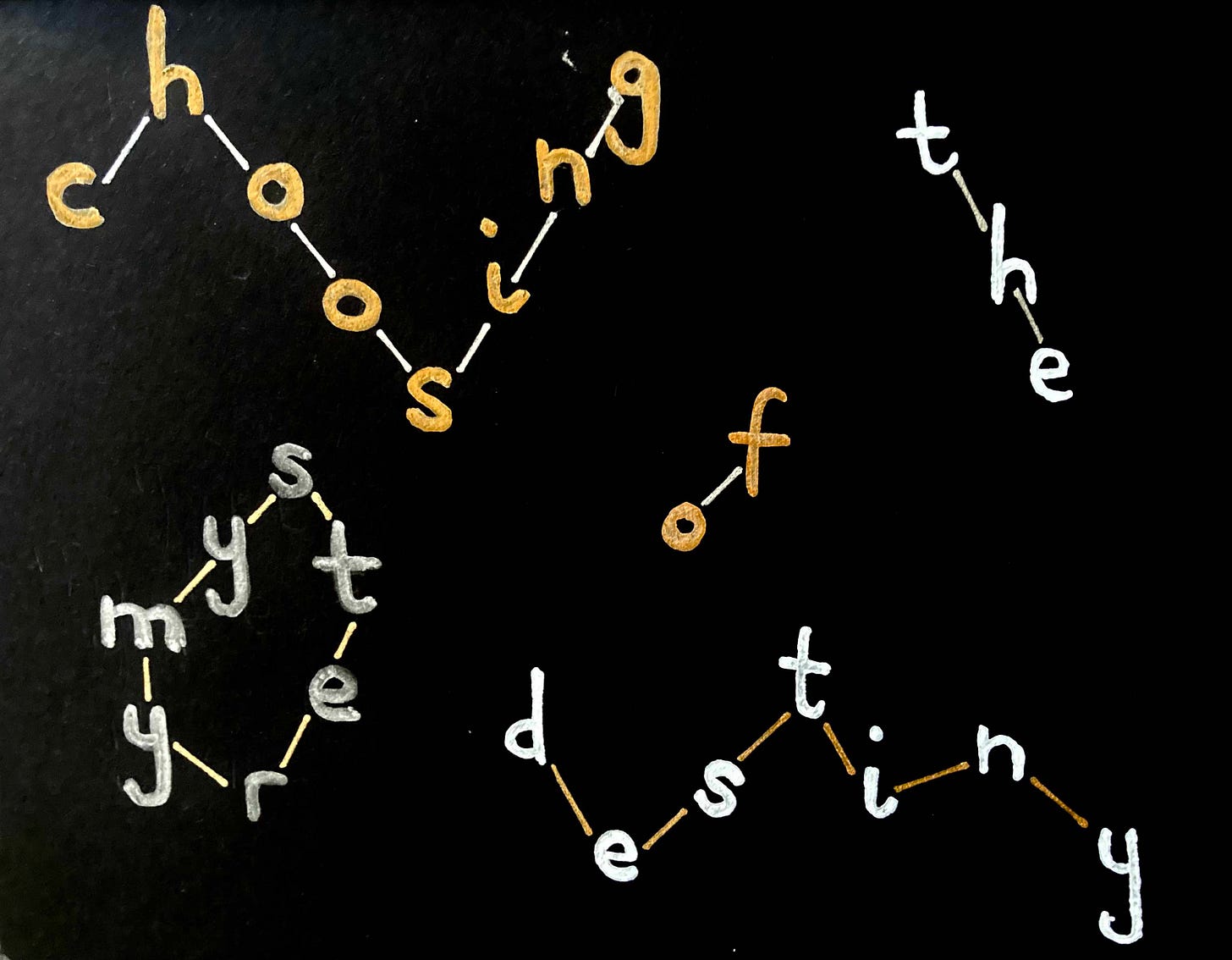
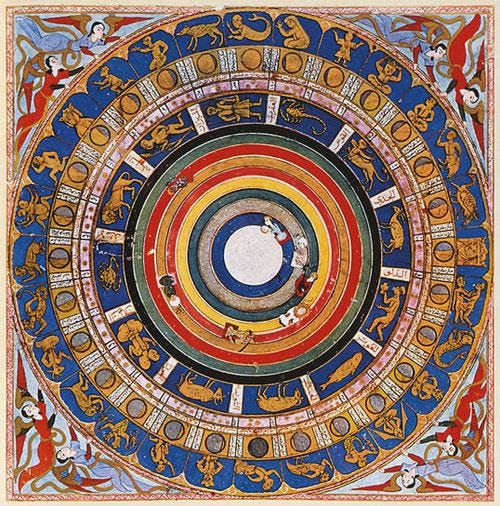
Lovely post! ♋️ 🦀 (I’m a Cancer)
Your newsletter is always so incredible. Every time, I walk away with new ideas and inspiration. I love the section on Holst and his "sonic translation of the seven planets (known at the time) and their emotional influence on our psyche."